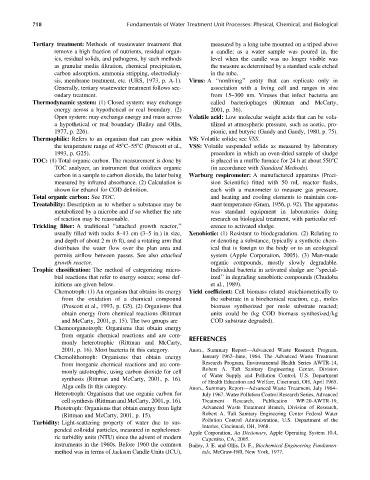Page 763 - Fundamentals of Water Treatment Unit Processes : Physical, Chemical, and Biological
P. 763
718 Fundamentals of Water Treatment Unit Processes: Physical, Chemical, and Biological
Tertiary treatment: Methods of wastewater treatment that measured by a long tube mounted on a tripod above
remove a high fraction of nutrients, residual organ- a candle; as a water sample was poured in, the
ics, residual solids, and pathogens, by such methods level when the candle was no longer visible was
as granular media filtration, chemical precipitation, the measure as determined by a standard scale etched
carbon adsorption, ammonia stripping, electrodialy- in the tube.
sis, membrane treatment, etc. (URS, 1973, p. A-1). Virus: A ‘‘nonliving’’ entity that can replicate only in
Generally, tertiary wastewater treatment follows sec- association with a living cell and ranges in size
ondary treatment. from 15–300 nm. Viruses that infect bacteria are
Thermodynamic system: (1) Closed system: may exchange called bacteriophages (Rittman and McCarty,
energy across a hypothetical or real boundary. (2) 2001, p. 36).
Open system: may exchange energy and mass across Volatile acid: Low molecular weight acids that can be vola-
a hypothetical or real boundary (Bailey and Ollis, tilized at atmospheric pressure, such as acetic, pro-
1977, p. 226). pionic, and butyric (Gaudy and Gaudy, 1980, p. 75).
Thermophilic: Refers to an organism that can grow within VS: Volatile solids; see VSS.
the temperature range of 458C–558C (Prescott et al., VSS: Volatile suspended solids as measured by laboratory
1993, p. G25). procedure in which an oven-dried sample of sludge
TOC: (1) Total organic carbon. The measurement is done by is placed in a muffle furnace for 24 h at about 5508C
TOC analyzer, an instrument that oxidizes organic (in accordance with Standard Methods).
carbon in a sample to carbon dioxide, the latter being Warburg respirometer: A manufactured apparatus (Preci-
measured by infrared absorbance. (2) Calculation is sion Scientific) fitted with 50 mL reactor flasks,
shown for ethanol for COD definition. each with a manometer to measure gas pressure,
Total organic carbon: See TOC. and heating and cooling elements to maintain con-
Treatability: Description as to whether a substance may be stant temperature (Gram, 1956, p. 92). The apparatus
metabolized by a microbe and if so whether the rate was standard equipment in laboratories doing
of reaction may be reasonable. research on biological treatment, with particular ref-
Trickling filter: A traditional ‘‘attached growth reactor,’’ erence to activated sludge.
usually filled with rocks 8–13 cm (3–5 in.) in size, Xenobiotic: (1) Resistant to biodegradation. (2) Relating to
and depth of about 2 m (6 ft), and a rotating arm that or denoting a substance, typically a synthetic chem-
distributes the water flow over the plan area and ical that is foreign to the body or to an ecological
permits airflow between passes. See also attached system (Apple Corporation, 2005). (3) Man-made
growth reactor. organic compounds, mostly slowly degradable.
Trophic classification: The method of categorizing micro- Individual bacteria in activated sludge are ‘‘special-
bial reactions that refer to energy source; some def- ized’’ in degrading xenobiotic compounds (Chudoba
initions are given below. et al., 1989).
Chemotroph: (1) An organism that obtains its energy Yield coefficient: Cell biomass related stoichiometrically to
from the oxidation of a chemical compound the substrate in a biochemical reaction, e.g., moles
(Prescott et al., 1993, p. G5). (2) Organisms that biomass synthesized per mole substrate reacted;
obtain energy from chemical reactions (Rittman units could be (kg COD biomass synthesized=kg
and McCarty, 2001, p. 15). The two groups are COD substrate degraded).
Chemoorganotroph: Organisms that obtain energy
from organic chemical reactions and are com- REFERENCES
monly heterotrophic (Rittman and McCarty,
2001, p. 16). Most bacteria fit this category. Anon., Summary Report—Advanced Waste Research Program,
Chemolithotroph: Organisms that obtain energy January 1962–June, 1964. The Advanced Waste Treatment
from inorganic chemical reactions and are com- Research Program, Environmental Health Series AWTR-14,
Robert A. Taft Sanitary Engineering Center, Division
monly autotrophic, using carbon dioxide for cell
of Water Supply and Pollution Control, U.S. Department
synthesis (Rittman and McCarty, 2001, p. 16).
of Health Education and Welfare, Cincinnati, OH, April 1965.
Alga cells fit this category. Anon., Summary Report—Advanced Waste Treatment, July 1964–
Heterotroph: Organisms that use organic carbon for July 1967. Water Pollution Control Research Series, Advanced
cell synthesis (Rittman and McCarty, 2001, p. 16). Treatment Research, Publication WP-20-AWTR-19,
Phototroph: Organisms that obtain energy from light Advanced Waste Treatment Branch, Division of Research,
(Rittman and McCarty, 2001, p. 15). Robert A. Taft Sanitary Engineering Center Federal Water
Pollution Control Administration, U.S. Department of the
Turbidity: Light-scattering property of water due to sus-
Interior, Cincinnati, OH, 1968.
pended colloidal particles, measured in nephelomet-
Apple Corporation, Aa Dictionary, Apple Operating System 10.4,
ric turbidity units (NTU) since the advent of modern Cupertino, CA, 2005.
instruments in the 1960s. Before 1960 the common Bailey, J. E. and Ollis, D. F., Biochemical Engineering Fundamen-
method was in terms of Jackson Candle Units (JCU), tals, McGraw-Hill, New York, 1977.

